Commercial Building Construction: How Much are the Commercial Construction Costs Per Square Foot?
Togal.AI
|
To begin commercial building construction and avoid cost overruns, make sure to determine the commercial construction costs per square foot. Do this by considering all the factors that affect the final price - the size, the type of building, location, and design.
In this article, explore how each factor affects the overall price of a commercial construction project. Once you’ve considered all factors, come up with an accurate and competitive cost estimate for your large-scale commercial building project using technology such as AI estimating software. This type of software can help you complete the takeoff process, thus allowing you to shift your focus towards value engineering and looking for suitable trade partners.
Disclaimer: The pricing stated here is based on average data from third-party research. Prices may still vary due to differences in seasonality and supplier.
What is Commercial Construction?
Commercial construction can be anywhere from designing, renovating, and building universities, healthcare centers, office high-rises, warehouses, shopping malls, hotels, to even retail centers. As long as the structure's primary use is “profit generation”, then it’s considered “commercial construction”.
There are three types of commercial construction: small-scale, medium-scale, and large-scale.
Small-Scale Commercial Construction
Rather than building a new structure from the ground up, small-scale commercial construction is strictly remodeling jobs. Their project timelines are usually shorter and require fewer employees, and fewer materials and equipment.
An example of small-scale commercial construction includes renovating office spaces and office buildings. Below are some examples of costs:
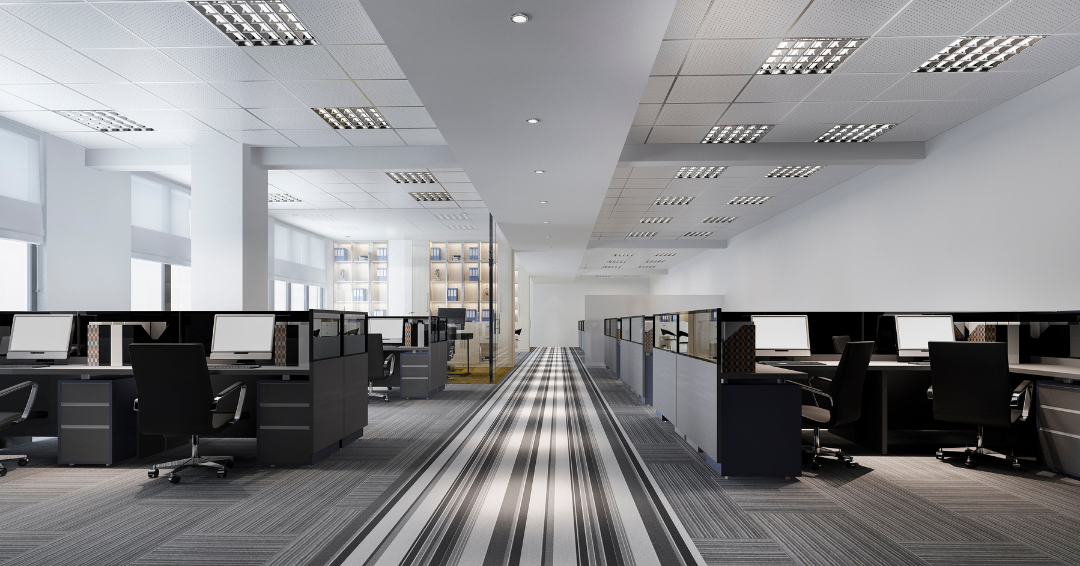
Medium-Scale Commercial Construction
Constructing a commercial building on a medium-scale involves upgrading, expanding, and starting from the ground up. The projects are more complicated than small-scale ones and therefore can take several months, or a year to finish.
The following are some examples of medium-scale constructions:

Large-Scale Commercial Construction
These are complex projects that create an entirely new structure from the ground up, or significantly change the overall output and layout of a building. Not only do they take years to finish, but they also need a high level of coordination among various teams and specialized equipment to finish.
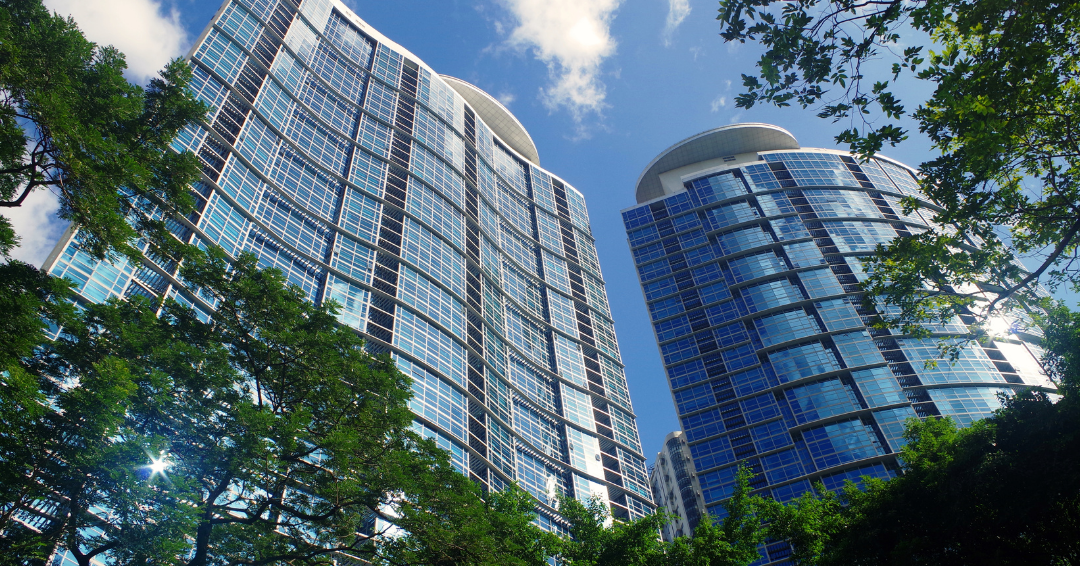
Commercial Construction Costs: By Location
When determining the cost of a commercial construction project, it is important to consider the location of the construction site because it can have a significant impact on the overall cost of the project.
The Impact of Location on Commercial Construction Costs
Labor Costs
Labor costs vary depending on the location of the construction site due to differences in wages and availability of skilled labor. Construction labor rates tend to be higher in urban areas than in rural areas due to higher living costs and increased competition for labor. This can affect the cost of the project since labor is typically one of the most significant expenses in a construction project.
Material Costs
The cost of construction materials also varies depending on the location of the construction site. The availability and transportation costs of building materials can vary significantly depending on the location, which can affect the overall cost of the project. For example, materials may be more expensive in remote areas where transportation costs are higher.
Building Codes and Regulations
Building codes and regulations can also vary depending on the location of the construction site. Some areas may require more extensive building permits or environmental impact studies, which can increase the cost of the project.
How to Ensure Accurate Cost Estimates
To ensure that your labor and material cost estimates are accurate per location, you should consider the following:
Conduct Research
Research the local labor rates and material costs in the area where the construction project is to be located. This can help you accurately estimate the cost of the project based on the location-specific factors.
Consult with Local Experts
Consult with local experts, such as contractors or architects who have experience working in the area. They can provide valuable insights into the specific factors that may affect the cost of the project in that location.
Factor in Other Location-Specific Costs
Consider any additional location-specific costs, such as transportation or permitting fees, that may affect the cost of the project. This will help you develop a more accurate cost estimation for the project.
By taking the location of the construction site into account and accurately estimating the labor and material costs per location, you can develop a more accurate cost estimation for your commercial construction project.
Commercial Construction Costs Per U.S. Region
Below are some of the average construction costs per select building type. We presented the figures per square foot, comparing the different construction prices per U.S. region. As shown below, medical centers are one of the most expensive building types to build. (Source: Big Rentz)

Evolution of Non-Residential Commercial Buildings in the U.S. from 2006 - 2023 in Million U.S. Dollars
The forecast below shows the rise and fall of construction spending for non-residential commercial construction in the U.S. The spending steadily rose from 2010 until 2018, but gradually fell from 2019 to 2021. By 2022, the construction spending gradually went on an upward trend once more.
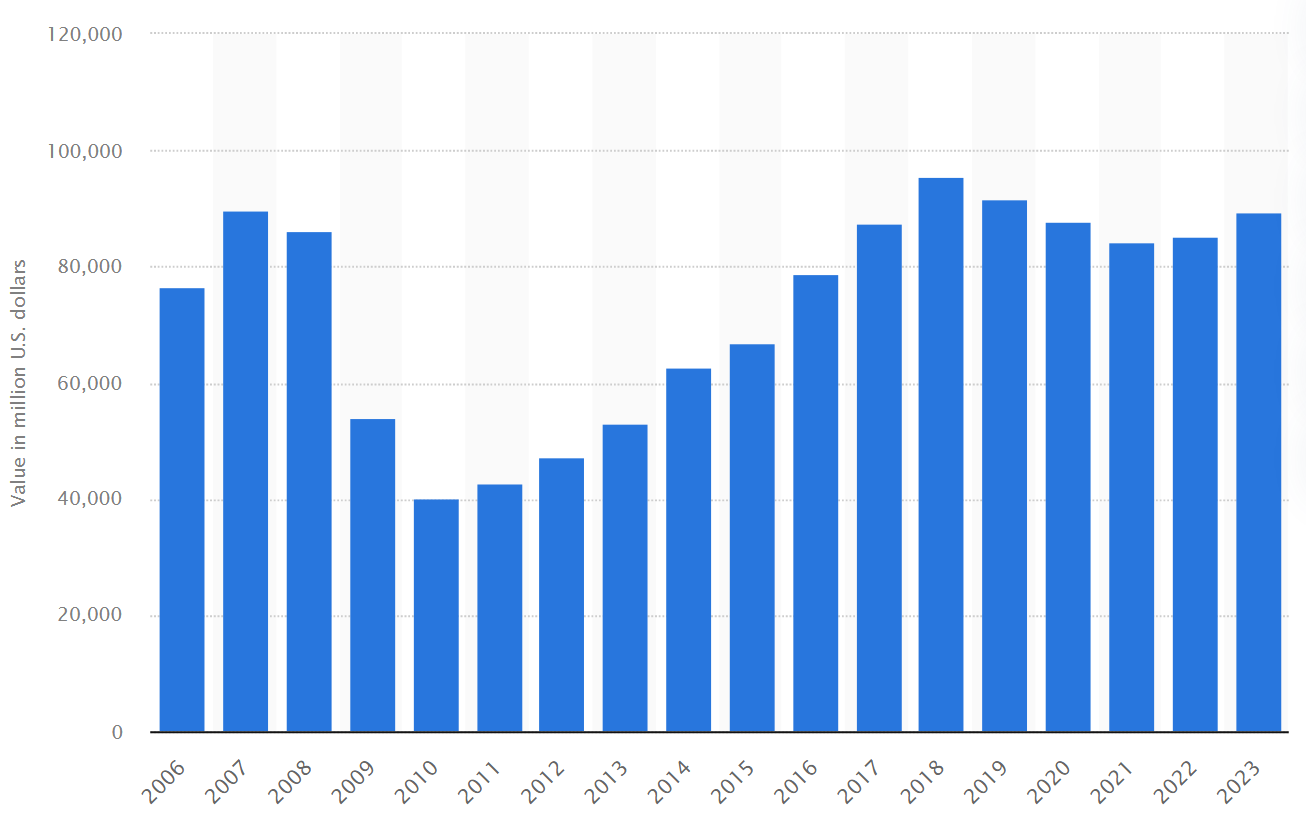
Commercial Construction Costs in the U.K.
The following shows the commercial construction costs of several building types in the U.K. per m2 of the gross internal floor area. Gross internal floor area refers to the internal area of the building that is measured over internal partitions and walls and stairway openings.
When determining the construction costs of the following commercial building types, the finishes, fittings, furnishings, equipment, services, main contractor’s overheads and profits, and preliminaries were all considered.
Construction Costs of Administrative, Commercial and Protective Service Entities in the U.K.
Source: Costmodelling
Construction Costs of Cultural, Educational, Scientific and Information Entities in the U.K.
Source: Costmodelling
Industrial entities in the U.K.
Source: Costmodelling
Construction Costs of Medical, Health, Welfare and Sanitary Entities in the U.K.
Source: Costmodelling
Construction Costs of Recreational Entities in the U.K.
Source: Costmodelling
Construction Costs of Sport and Activity Entities in the U.K.
Source: Costmodelling
Construction Costs of Hotels and Hostels in the U.K.
Source: Costmodelling
Commercial Construction Costs Per Square Foot and By Building Type
Commercial construction costs vary depending on the building type for several reasons, such as:
- Structural Design
The structural design of different types of buildings depends on their intended use. For example, a hospital building will require heavier structural elements to support medical equipment, while an office building will have lighter structures to support office equipment. These different structural designs can have an impact on construction costs.
- Building Systems
Various building types require varying mechanical, electrical, and plumbing systems. A hospital building will require more complex and sophisticated systems to support the medical equipment and provide a clean and sterile environment, while an office building may require fewer systems. The complexity and sophistication of building systems will affect the cost of the project.
- Building Materials
To achieve their intended purpose, different building types require different building materials. For example, a hotel building will require more durable and aesthetically pleasing materials to create a welcoming environment, while a school building may require more practical and affordable materials.
- Specialized Equipment and Features
Some building types may require specialized equipment or features that are not found in other types of buildings. For example, a hospital building may require specialized medical equipment and features, such as operating rooms and intensive care units, while a hotel may require specialized amenities such as swimming pools, spas, and restaurants. These specialized features and equipment can significantly impact the cost of the project.
- Building Codes and Regulations
Different building types are subject to different building codes and regulations, which can affect the construction cost. For example, a hospital building may require more extensive fire protection systems, which can increase the cost of the project.
Commercial Costs Per Building Type
As shown below, two of the most expensive commercial building types to build include the acute care medical facility, museums, and performing arts centers. Acute care facilities require specialized equipment such as medical gas systems and backup power systems that are costly to install.
Performing arts centers require highly specialized acoustic and lighting systems. Lastly, museums need specialized climate control systems, lighting,g and security systems to protect the highly valuable artworks and artifacts. All of these factors lead to its high overall construction costs.
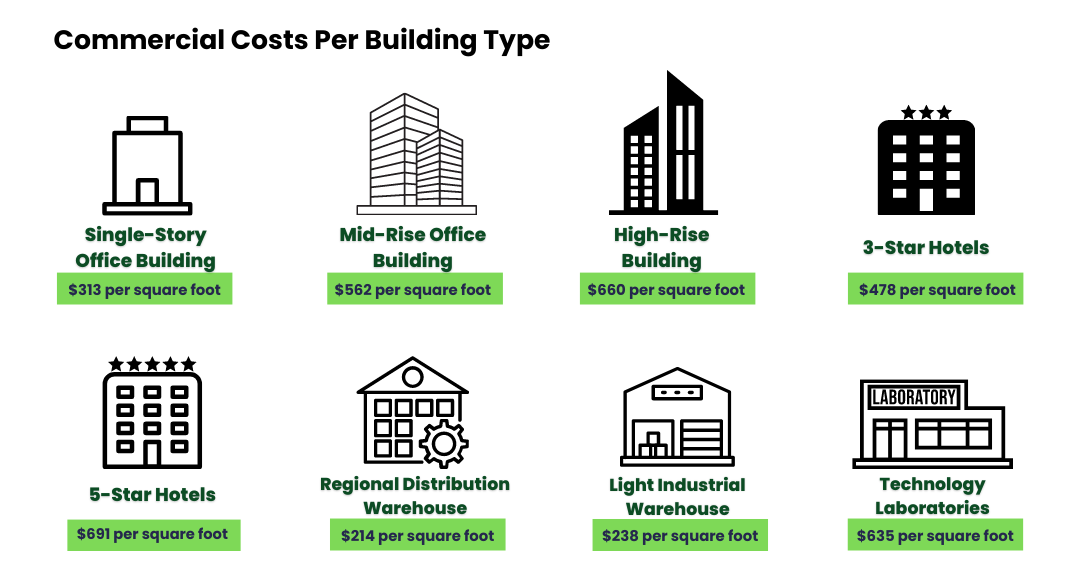
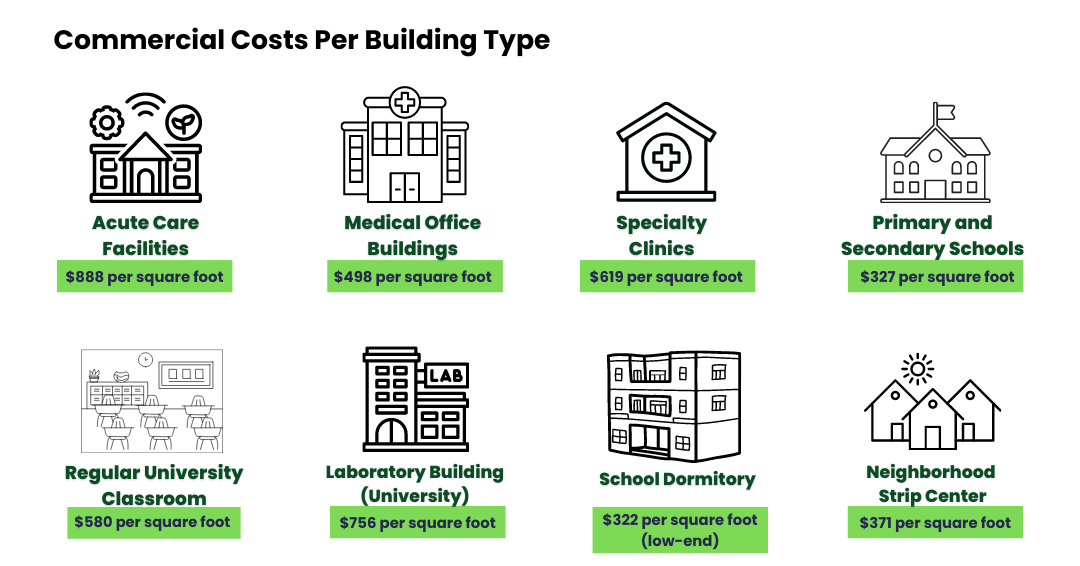

Commercial Construction Cost Breakdown
Here are some of the other factors that affect the overall commercial construction cost.
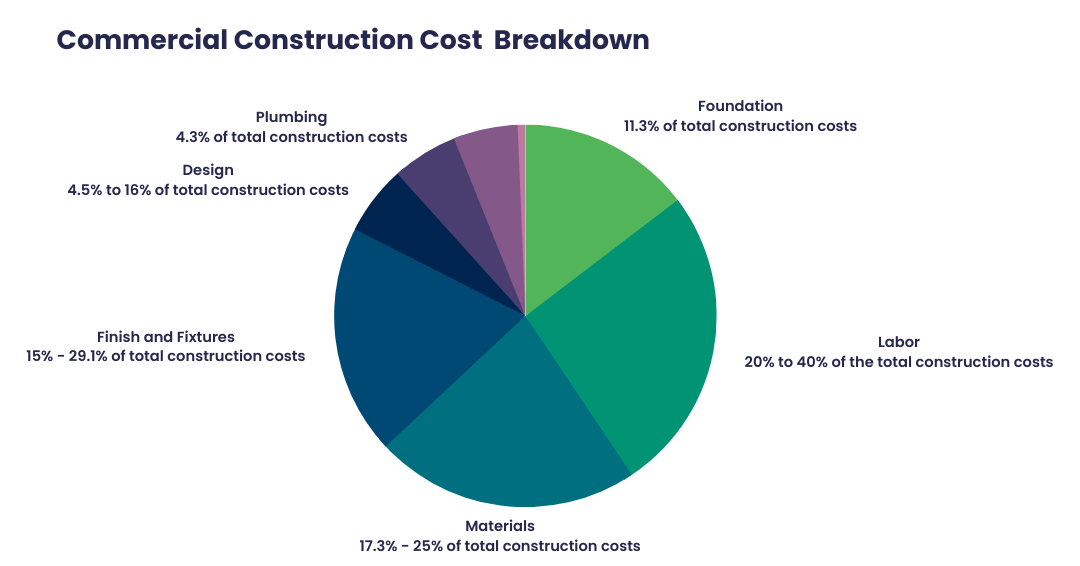
Other Costs to Consider
Aside from material and labor costs, here are some of the other fees you’ll need to look out for when building your commercial building.
- Hard Costs - The direct expenses associated with the physical construction of the building, including labor, materials, and equipment costs, typically the most substantial portion of the overall project cost.
- Soft Costs - The indirect expenses associated with the project, including design fees, legal fees, permits, and insurance, which can add up and significantly impact the overall project cost.
- Long-Term Cost - The ongoing expenses associated with the maintenance, repairs, and utilities of the building after construction, which can significantly impact the overall cost of the building over its lifespan.
How to Estimate Commercial Building Costs
Factors that affect the final price include the size, type of building, location, and design. The cost of labor, materials and building codes, and regulations can also vary depending on the location of the construction site, affecting the overall cost of the project.
To ensure accurate cost estimates, research local labor rates and material costs, consult with local experts, and factor in other location-specific costs. Finally, it is vital to use technology such as AI estimating software to complete the takeoff process in seconds with 99% accuracy and shift your focus towards value engineering and finding suitable trade partners.
Doing so will help you ensure competitive cost estimates and project proposals, and increase the overall profitability of your commercial construction project. Experience how Togal.AI can streamline your preconstruction workflow and help you bid on and win more work.
